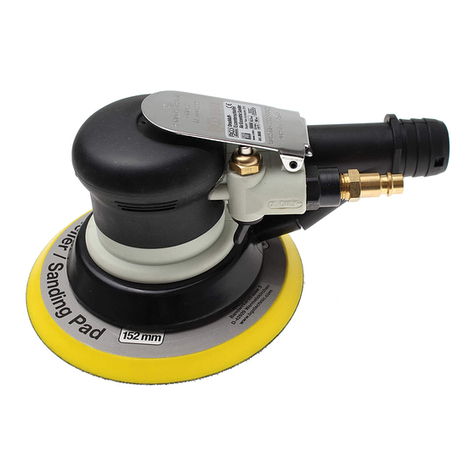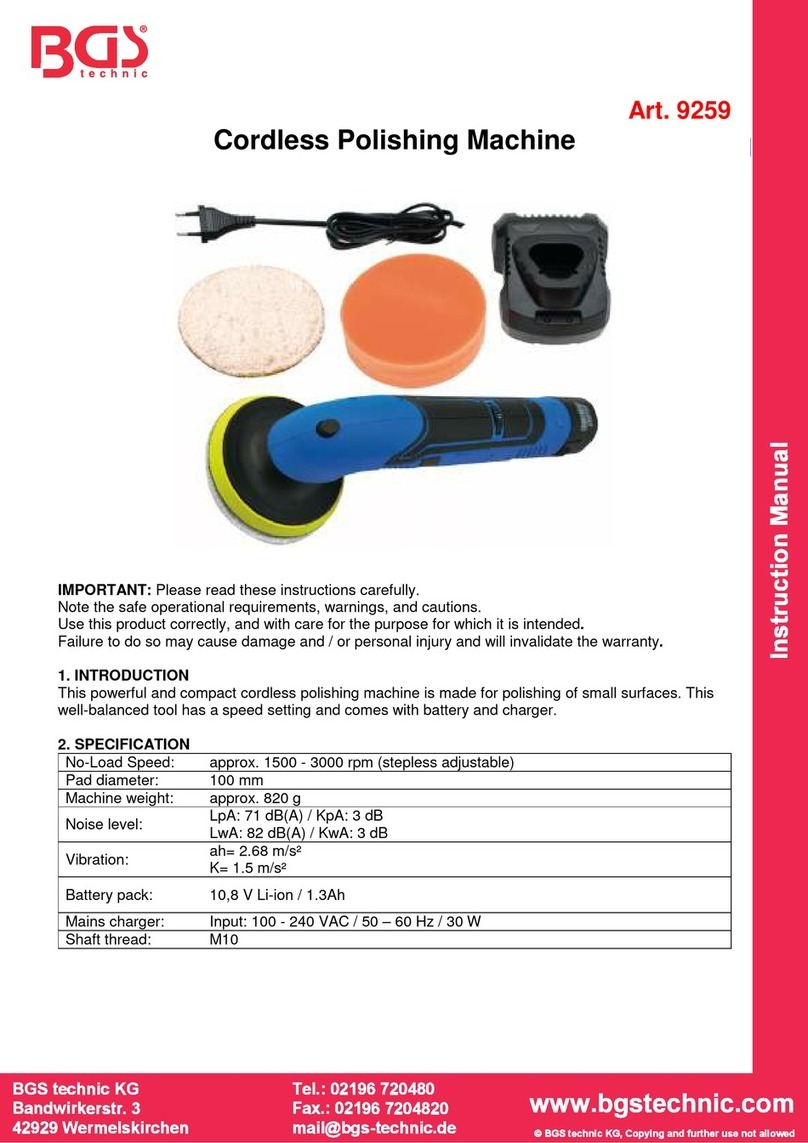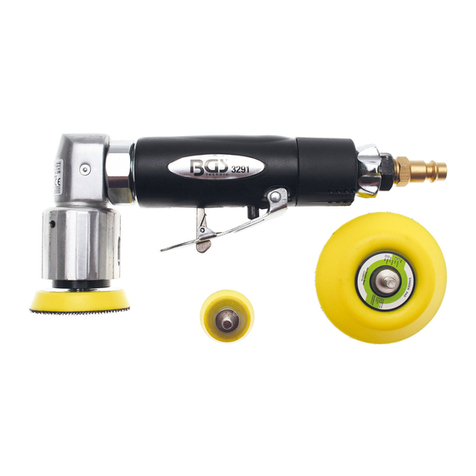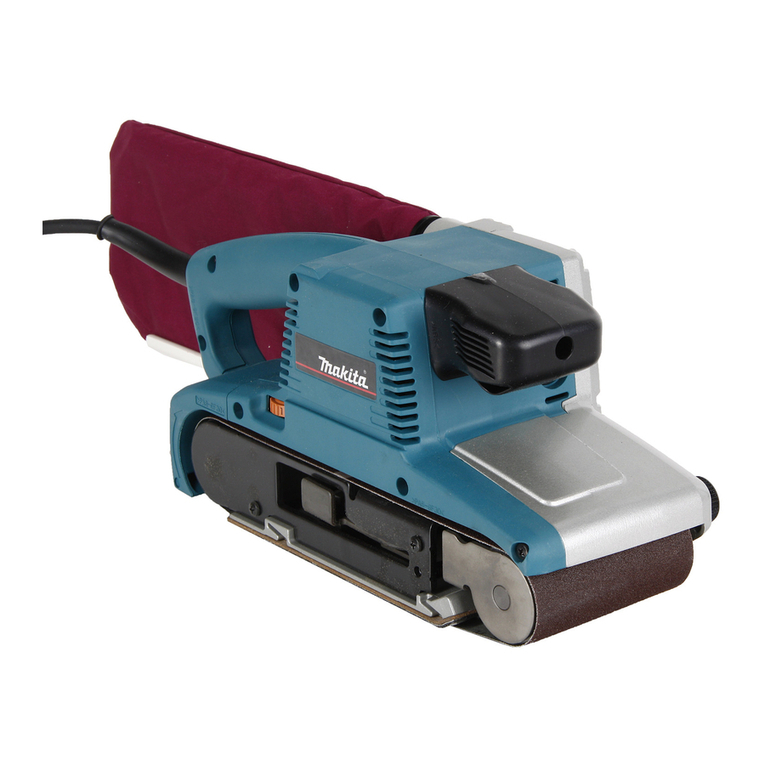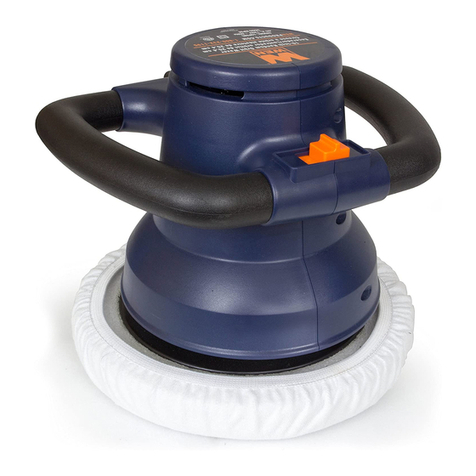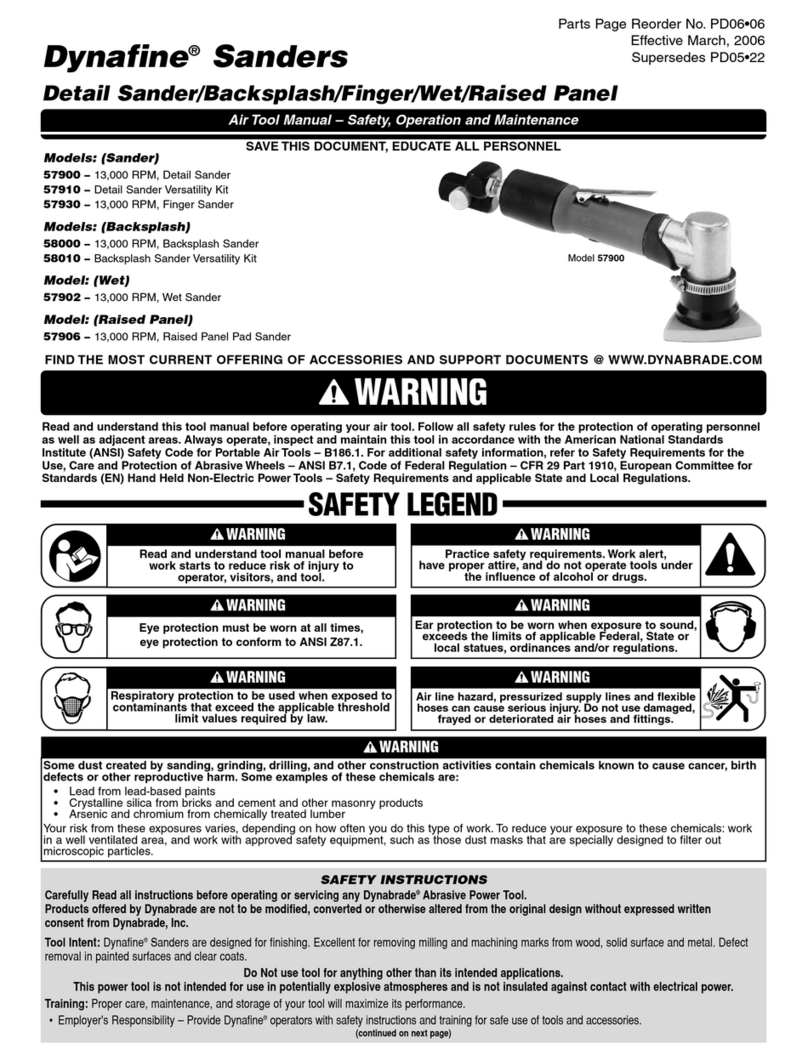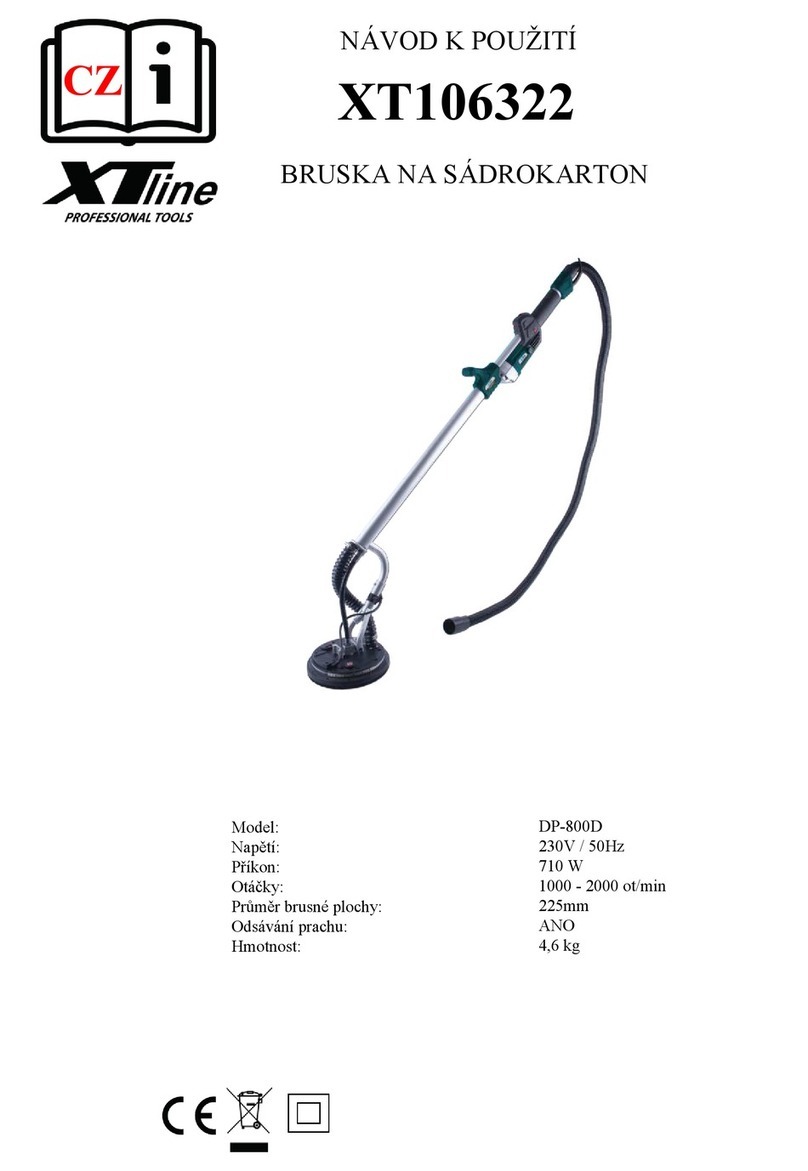BGS technic 9345 User manual

BGS technic KG
Bandwirkerstr. 3
42929 Wermelskirchen
Tel.: 02196 720480
Fax.: 02196 7204820
mail@bgs-technic.de
www.bgstechnic.com
© BGS technic KG, Vervielfältigung und Weiterverwendung verboten
Art. 9345
Elektro-Exzenter-Poliermaschine
TECHNISCHE DATEN
Spannung: 230-240 V ~50 Hz
Leistung: 900 W
Max. Leerlaufdrehzahl: 6000 U/min
Max. Durchmesser: 150 mm
Schalldruckpegel LpA: 80,27 dB (A)
Schallleistungspegel LwA: 91,27 dB (A)
Vibrationsspegel: ahd=6,759 m/s² / K=1,5 m/s²
Schutzklasse: II
OPTIONALES ZUBEHÖR
Polierschwamm, Ø150mm (BGS 9345-1)
Polierteller mit Klettsystem, Ø150mm (BGS 9345-2)
ALLGEMEINE SICHERHEITSHINWEISE
•WARNUNG! Beachten Sie alle Sicherheitshinweise und Anweisungsschritte. Eine Missachtung
kann zu Stromschlag, Brand und/oder schweren Verletzungen führen.
•Bewahren Sie alle Sicherheitshinweise zum späteren Nachschlagen auf. Der in den
Sicherheitshinweisen verwendete Begriff „Elektrowerkzeug“ bezieht sich auf Ihr netz-
(kabelgebundenes) oder akkubetriebenes (kabelloses) Elektrowerkzeug.
SICHERHEIT IM ARBEITSBEREICH
•Halten Sie den Arbeitsbereich sauber und gut beleuchtet. In unübersichtlichen oder dunklen
Bereichen besteht erhöhte Unfallgefahr.
•Setzen Sie Elektrowerkzeuge nicht in explosionsgefährdeten Bereichen ein, etwa in Gegenwart
von brennbaren Flüssigkeiten, Gasen oder Staub. Elektrowerkzeuge erzeugen Funken, die
Staub oder Dämpfe entzünden können.
•Halten Sie Kinder und andere Personen vom betriebenen Elektrowerkzeug fern. Durch
Ablenkung können Sie die Kontrolle über das Werkzeug verlieren.
SICHERHEIT BEI SPANNUNGSNETZEN
•Die Stecker am Elektrowerkzeug müssen in die Steckdosen passen. Verändern Sie niemals
einen Stecker. Befestigen Sie an geerdeten Elektrowerkzeugen keine Adapterstecker.
Originalstecker und passende Steckdosen verringern die Stromschlaggefahr.
•Meiden Sie den Körperkontakt mit geerdeten Flächen wie Rohren, Heizkörpern, Herden und
Kühlschränken. Wenn Ihr Körper geerdet ist, besteht erhöhte Stromschlaggefahr.
•Schützen Sie Elektrowerkzeuge vor Regen und Nässe. Eindringendes Wasser erhöht die
Stromschlaggefahr.
•Benutzen Sie das Kabel vorschriftsgemäß. Verwenden Sie das Kabel niemals zum Tragen,
Ziehen oder zur Trennung von der Stromversorgung des Elektrowerkzeugs. Halten Sie das
Kabel von Hitze, Öl, scharfen Kanten oder beweglichen Teilen fern. Beschädigte oder
verwickelte Kabel erhöhen die Stromschlaggefahr.
•Bei Arbeiten im Freien schließen Sie ein für Außenbereiche zugelassenes Verlängerungskabel
an. Die Verwendung eines für den Außeneinsatz geeigneten Kabels reduziert das Risiko eines
Stromschlags.
•Wenn sich der Betrieb eines Elektrowerkzeugs an einem feuchten Ort nicht vermeiden lässt,
setzen Sie einen Fehlerstromschutzschalter ein. Die Verwendung eines
Fehlerstromschutzschalters reduziert das Risiko eines Stromschlags.

BGS technic KG
Bandwirkerstr. 3
42929 Wermelskirchen
Tel.: 02196 720480
Fax.: 02196 7204820
mail@bgs-technic.de
www.bgstechnic.com
© BGS technic KG, Vervielfältigung und Weiterverwendung verboten
SICHERER UMGANG
•Handeln Sie beim Gebrauch von Elektrowerkzeugen umsichtig und sachgerecht. Gebrauchen
Sie kein Elektrowerkzeug, wenn Sie übermüdet sind oder unter dem Einfluss von Drogen,
Alkohol oder Medikamenten stehen. Unachtsamer Gebrauch kann zu schweren Verletzungen
führen.
•Legen Sie eine Schutzausrüstung an. Tragen Sie immer einen Augenschutz. Fachgerechte
Schutzausrüstung wie Atemschutzmaske, rutschfeste Sicherheitsschuhe, Schutzhelm oder
Gehörschutz vermindert die Verletzungsgefahr.
•Verhindern Sie versehentliches Starten des Werkzeugs. Der Schalter muss auf Aus stehen,
bevor Sie das Werkzeug aufnehmen oder transportieren, an eine Stromquelle oder ein
Akkupack anschließen. Wenn Sie das Elektrowerkzeug beim Transport am Hauptschalter
berühren, oder das Werkzeug bei eingeschaltetem Hauptschalter unter Spannung gesetzt wird,
kann es zu Unfällen kommen.
•Entfernen Sie vor dem Einschalten alle Einstell- oder Schraubenschlüssel. Schlüssel, die an
rotierenden Werkzeugteilen stecken, können zu Verletzungen führen.
•Lehnen Sie sich nicht über das Werkzeug. Behalten Sie stets sicheren Halt und das
Gleichgewicht. So ist in unerwarteten Situationen eine leichtere Kontrolle des Elektrowerkzeugs
möglich.
•Kleiden Sie sich richtig. Tragen Sie keine lose Kleidung oder Schmuck. Schützen Sie Haare,
Kleidung und Handschuhe vor beweglichen Teilen. Lose Kleidung, Schmuck oder lange Haare
können sich in beweglichen Teilen verfangen.
•Sind Geräte für den Anschluss von Entstaubungs- und Absauganlagen vorgesehen, müssen
diese angeschlossen und ordnungsgemäß verwendet werden. Der Einsatz einer
Staubabscheidung kann durch Staubbildung bedingte Gefahren reduzieren.
EINSATZ UND BEHANDLUNG VON ELEKTROWERKZEUGEN
•Das Elektrowerkzeug darf nicht gewaltsam eingesetzt werden. Benutzen Sie
zweckentsprechende Elektrowerkzeuge. Mit dem korrekten Elektrowerkzeug wird die Arbeit
besser und sicherer und unter vorschriftsgemäßer Geschwindigkeit ausgeführt.
•Gebrauchen Sie das Elektrowerkzeug nicht, wenn es sich über den Hauptschalter nicht korrekt
ein- und ausschalten lässt. Elektrowerkzeuge, die nicht über den Schalter geregelt werden
können, sind gefährlich und müssen repariert werden.
•Trennen Sie den Stecker von der Stromquelle bzw. den Akkupack, bevor Sie am
Elektrowerkzeug Einstellungen vornehmen, Zubehör austauschen oder das Werkzeug lagern.
Solche vorbeugenden Sicherheitsmaßnahmen verringern das Risiko, dass das Elektrowerkzeug
versehentlich gestartet wird.
•Bewahren Sie ungenutzte Elektrowerkzeuge außerhalb der Reichweite von Kindern auf und
lassen Sie Personen, die mit dem Elektrowerkzeug oder dieser Anleitung nicht vertraut sind, das
Gerät nicht bedienen. Für unerfahrene Benutzer sind Elektrowerkzeuge gefährlich.
•Warten Sie Elektrowerkzeuge regelmäßig. Überprüfen Sie bewegliche Teile auf mangelhafte
Ausrichtung oder Verbindung, Bruch und sonstige Beeinträchtigungen eines sicheren
Gebrauchs. Falls das Elektrowerkzeug beschädigt ist, lassen Sie es vor Gebrauch
instandsetzen. Viele Unfälle werden durch schlecht gewartete Elektrowerkzeuge verursacht.
•Halten Sie die Schneidwerkzeuge scharf und sauber. Korrekt gewartete Schneidwerkzeuge mit
scharfen Schneidkanten bleiben weniger leicht stecken und lassen sich leichter unter Kontrolle
behalten.
•Gebrauchen Sie das Elektrowerkzeug, Zubehör und Werkzeugteile usw. gemäß dieser
Anleitung unter Berücksichtigung der Arbeitsbedingungen und der auszuführenden Arbeiten.
Nicht bestimmungsgemäßer Einsatz kann zu gefährlichen Situationen führen.

BGS technic KG
Bandwirkerstr. 3
42929 Wermelskirchen
Tel.: 02196 720480
Fax.: 02196 7204820
mail@bgs-technic.de
www.bgstechnic.com
© BGS technic KG, Vervielfältigung und Weiterverwendung verboten
SICHERHEITSHINWEISE FÜR ALLE ARBEITSABLÄUFE
•Dieses Elektrowerkzeug dient als Poliermaschine. Beachten Sie alle beigefügten
Sicherheitshinweise, Anweisungen, Abbildungen und technischen Daten zu diesem
Elektrowerkzeug. Eine Missachtung kann zu Stromschlag, Brand und/oder schweren
Verletzungen führen.
•Dieses Elektrowerkzeug ist nicht geeignet für Schleif-, Bürst- oder Schneidearbeiten.
Unsachgemäßer Gebrauch kann zu Schäden und Verletzungen führen.
•Belassen Sie keinen Teil der Polierhaube oder ihrer Befestigungsschnüre freidrehend.
Verstauen oder kürzen Sie etwaige lose Befestigungsschnüre. Freidrehende
Befestigungsschnüre können sich verfangen oder am Werkstück hängen bleiben.
•Setzen Sie kein Zubehör ein, das nicht eigens vom Werkzeughersteller entwickelt und
empfohlen worden ist. Auch wenn das Zubehör an Ihrem Elektrowerkzeug befestigt werden
kann, ist ein sicherer Betrieb trotzdem nicht gewährleistet.
•Die Nenndrehzahl des Zubehörs sollte mindestens der auf dem Elektrowerkzeug angegebenen
Höchstdrehzahl entsprechen. Zubehörteile, bei denen die Nenndrehzahl überschritten wird,
können brechen.
•Außendurchmesser und Dicke Ihres Zubehörs sollten den Leistungsgrenzen Ihres
Elektrowerkzeugs entsprechen. Falsch ausgelegtes Zubehör lässt sich nicht ausreichend
sichern oder unter Kontrolle behalten.
•Die Wellenmaße von Polierscheiben, Flanschen, Poliertellern oder anderem Zubehör müssen
genau auf die Spindel des Elektrowerkzeugs abgestimmt sein. Zubehör mit von den Aufsätzen
des Elektrowerkzeugs abweichenden Wellenbohrungen gerät aus dem Gleichgewicht, vibriert
übermäßig und kann zum Verlust der Kontrolle über das Gerät führen.
•Setzen Sie kein beschädigtes Zubehör ein. Überprüfen Sie vor jedem Gebrauch alle
Polierscheiben auf Späne und Risse, Polierteller auf Risse oder übermäßigen Verschleiß,
Drahtbürsten auf lose oder gerissene Drähte. Sollte das Werkzeug oder ein Zubehörteil
herunterfallen, überprüfen Sie dieses auf Beschädigungen bzw. tauschen Sie es gegen
unbeschädigtes Zubehör. Halten Sie nach dem Überprüfen und Anbringen von Zubehör sich
und umstehende Personen von der Ebene der rotierenden Bauteile fern und betreiben Sie das
Elektrowerkzeug eine Minute lang bei maximaler Leerlaufdrehzahl. In dieser Testphase sollte
etwaiges beschädigtes Zubehör brechen.
•Tragen Sie je nach Anwendungsfall Schutzausrüstung, nutzen Sie eine Sichtscheibe oder eine
Schutzbrille. Tragen Sie bei Bedarf Atemschutzmaske, Gehörschutz, Handschuhe und
Werkstattschürze, die kleine Polier- oder Werkstückfragmente abfangen können. Der
Augenschutz sollte umherfliegende Späne abfangen können. Atemschutzmaske bzw. -gerät
sollte zur Filterung von Partikeln geeignet sein, die bei Ihren Arbeiten entstehen können. Sind
Sie längere Zeit starkem Lärm ausgesetzt, kann dies zu Hörverlust führen.
•Halten Sie umstehende Personen in einem vorschriftsgemäßen Sicherheitsabstand vom
Arbeitsbereich fern. Wer den Arbeitsbereich betritt, muss entsprechende Schutzausrüstung
tragen. Fragmente des Werkstücks oder gebrochenen Zubehörs können umherfliegen und
Verletzungen außerhalb des unmittelbaren Arbeitsbereichs verursachen.
•Verlegen Sie die Stromleitung in ausreichender Entfernung von drehenden Teilen. Falls Sie die
Kontrolle über das Werkzeug verlieren, kann die Leitung abgeschnitten oder verspannt und Ihre
Hand oder sogar Ihr Arm in drehende Teile geraten.
•Legen Sie das Elektrowerkzeug niemals ab, bevor alle drehenden Teile völlig stillstehen.
Drehende Teile können an der Auflagefläche reiben und das Elektrowerkzeug unkontrollierbar
werden lassen.
•Lassen Sie das Elektrowerkzeug nicht in Betrieb, während Sie es an Ihrer Seite tragen. Bei
versehentlicher Berührung können sich drehende Teile in Ihrer Kleidung verfangen und an Ihren
Körper gelangen.
•Reinigen Sie die Lüftungsöffnungen des Elektrowerkzeugs regelmäßig. Der Motorlüfter zieht
Staub in das Gehäuse. Eine übermäßige Ansammlung von Metallpulver kann zu
Stromschlaggefahr führen.
•Gebrauchen Sie das Elektrowerkzeug nicht in der Nähe brennbarer Materialien. Diese können
sich durch Funkenflug entzünden.
•Gebrauchen Sie kein Zubehör, das flüssige Kühlmittel benötigt. Durch den Gebrauch von
Wasser oder anderen flüssigen Kühlmitteln kann es zu Stromschlägen kommen.

BGS technic KG
Bandwirkerstr. 3
42929 Wermelskirchen
Tel.: 02196 720480
Fax.: 02196 7204820
mail@bgs-technic.de
www.bgstechnic.com
© BGS technic KG, Vervielfältigung und Weiterverwendung verboten
SICHERHEITSHINWEISE BEI RÜCKSCHLÄGEN
•Als Rückschlag oder auch Kick-back wird ein plötzliches Verhalten beim Verfangen eines
drehenden Teils bezeichnet. Beim Verfangen kommt das drehende Teil abrupt zum Stillstand,
so dass sich das Elektrowerkzeug an der Anschlussstelle unkontrollierbar in die
entgegengesetzte Richtung bewegt.
•Wird beispielsweise eine Polierscheibe am Werkstück eingeklemmt, kann sich deren Kante an
der Klemmstelle in die Werkstoffoberfläche eingraben, wodurch die Scheibe herausspringt. Je
nach Drehrichtung springt die Scheibe dann zum Bediener hin oder von ihm weg.
Polierscheiben können dabei auch brechen.
•Rückschlag durch unsachgemäßen Gebrauch von Elektrowerkzeugen und/oder falsche
Vorgehensweise oder Umstände kann durch unten stehende Vorsichtsmaßnahmen vermieden
werden.
•Halten Sie das Elektrowerkzeug fest und halten Sie Körper und Arm in angemessener Position,
um Rückschlagskräfte zu vermeiden. Zur Abfederung von Rückschlägen oder
Gegendrehmomenten beim Starten sollten Sie einen ggf. vorhandenen Hilfsgriff ebenfalls stabil
festhalten. Gegendrehmomente und Rückschlagkräfte können Sie durch entsprechende
Vorsichtsmaßnahmen unter Kontrolle behalten.
•Bringen Sie Ihre Hand niemals in die Nähe drehender Teile. Sie könnten über Ihre Hand
zurückschlagen.
•Stellen Sie sich nicht in den Bereich, in dem sich das Elektrowerkzeug bewegen würde, falls es
zu Rückschlägen kommt. Ein Rückschlag treibt das Werkzeug beim Verfangen unmittelbar
entgegen der Drehrichtung der Scheibe.
•Gehen Sie bei der Bearbeitung von Ecken, scharfen Kanten usw. besonders vorsichtig vor.
Vermeiden Sie, dass sich drehende Teile verfangen oder vibrieren. An Ecken, scharfen Kanten
oder beim Vibrieren verfangen sich drehende Teile besonders leicht und führen zu
unkontrollierbarem Verhalten oder Rückschlag.
•Setzen Sie keine Sägekette, kein Schnitzmesser und kein gezahntes Sägeblatt ein. Derartige
Klingen verursachen besonders häufig Rückschlag und unkontrollierbares Verhalten.
SYMBOLE
Auf dem Produkt, dem Typenschild und in dieser Anleitung finden Sie unter anderem die folgenden
Symbole und Abkürzungen. Machen Sie sich mit ihnen vertraut, damit es nicht zu Personen- und
Sachschäden kommt.
V~
Volt (Wechselstrom)
mm
Millimeter
Hz
Hertz
kg
Kilogramm
W
Watt
dB(A)
Dezibel (A-bewertet)
/min
Umdrehungen pro Minute
m/s²
Meter pro Sekunde zum Quadrat
Verriegeln zum
Anziehen/Sichern
Entriegeln zum Lösen
Hinweis/Anmerkung
Vorsicht/Warnung
Lesen Sie die
Bedienungsanleitung
Tragen Sie einen Gehörschutz
Tragen Sie einen
Augenschutz
Tragen Sie eine Staubmaske
Tragen Sie
Schutzhandschuhe
Tragen Sie
rutschfestes Sicherheitsschuhwerk

BGS technic KG
Bandwirkerstr. 3
42929 Wermelskirchen
Tel.: 02196 720480
Fax.: 02196 7204820
mail@bgs-technic.de
www.bgstechnic.com
© BGS technic KG, Vervielfältigung und Weiterverwendung verboten
SYMBOLE
Schalten Sie das Gerät aus und trennen Sie es von der Spannungsversorgung, bevor Sie
Zusatzteile anbringen, es reinigen, einstellen, warten, lagern oder transportieren.
Dieses Produkt gehört der Schutzklasse II an. Das bedeutet, dass es mit einer erhöhten
oder doppelten Isolierung ausgestattet ist.
Das Produkt entspricht den geltenden europäischen Richtlinien. Deren Einhaltung wurde
sachgerecht überprüft.
WEEE-Symbol. Elektroaltgeräte dürfen nicht im Hausmüll entsorgt werden. Zur
Wiederverwendung wenden Sie sich an die zuständigen Stellen. Informieren Sie sich bei
Ihrer Gemeinde oder Ihrem zuständigen Händler über Recyclingmöglichkeiten.
ALLGEMEIN
•Gebrauchen Sie dieses Werkzeug nur zum Trockenpolieren.
•Nutzen Sie nur mitgelieferte Sortimente.
•Dieses Werkzeug sollte nicht von Personen unter 16 Jahren betrieben werden.
•Trennen Sie immer den Stecker von der Steckdose, bevor Sie Einstellungen vornehmen oder
Zubehörteile austauschen.
•Bearbeiten Sie keine asbesthaltigen Materialien: Asbest gilt als krebserregend.
ZUBEHÖR
•Gebrauchen Sie nur Zubehörteile mit einer zulässigen Drehzahl, die mindestens der höchsten
Leerlaufdrehzahl des Werkzeugs entspricht.
•Benutzen Sie niemals nicht zugelassenes Zubehör.
•Gebrauchen Sie kein beschädigtes, verformtes oder vibrierendes Zubehör.
EINSATZ IM FREIEN
•Bei Einsatz im Freien schließen Sie das Gerät über einen Fehlerstromschutzschalter (FI) mit
einem Auslösestrom von maximal 30 mA an und nutzen ein für Außenbereiche zugelassenes
Verlängerungskabel mit spritzwassergeschützter Steckkupplung.
VOR GEBRAUCH
•Die Versorgungsspannung muss der auf dem Typenschild des Werkzeugs angegebenen
Spannung entsprechen (Werkzeuge mit einer Leistung von 230 V oder 240 V können auch an
eine 220 V Versorgung angeschlossen werden).
•Werkstoffstaub von bleihaltigen Farben, einigen Holzarten, Mineralien und Metallen kann
schädlich sein: Bei Hautkontakt oder Einatmen können allergische Reaktionen und/oder
Atemwegserkrankungen auftreten. Tragen Sie eine Atemschutzmaske und arbeiten Sie mit
einem Absauggerät, sofern eines angeschlossen werden kann.
•Einige Staubarten werden als krebserregend eingestuft (z. B. Eichen- und Buchenstaub),
insbesondere in Verbindung mit Zusatzstoffen zur Holzaufbereitung; tragen Sie eine Staubmaske
und arbeiten Sie mit einem Absauggerät, sofern eines angeschlossen werden kann.
•Beachten Sie die bei Staubauftritt geltenden Richtlinien für die zu bearbeitenden Werkstoffe
•Befestigen Sie das Werkstück: Ein mit Spannvorrichtungen oder in einem Schraubstock
eingespanntes Werkstück wird sicherer gehalten als von Hand.
•Spannen Sie das Werkzeug nicht in einen Schraubstock.
•Benutzen Sie vollständig abgerollte und gesicherte Verlängerungskabel mit einer Kapazität von
10 A.

BGS technic KG
Bandwirkerstr. 3
42929 Wermelskirchen
Tel.: 02196 720480
Fax.: 02196 7204820
mail@bgs-technic.de
www.bgstechnic.com
© BGS technic KG, Vervielfältigung und Weiterverwendung verboten
NACH GEBRAUCH
•Schalten Sie vor dem Ablegen des Werkzeugs den Motor aus. Alle beweglichen Teile müssen
völlig stillstehen.
•Nach dem Ausschalten dürfen Sie die rotierenden Teile niemals durch eine entgegengesetzte
Kraft bremsen.
BESCHREIBUNG
A Geschwindigkeitsregler
B Feststellknopf Ein-/Ausschalter
C Ein-/Ausschalter
D
Polierscheibe
E Polierschwamm
F Lüftungsschlitze
G Sechskantschlüssel 6 mm
VORBEREITUNG
•Den Griff aufrecht an der Maschine befestigen, dazu die mitgelieferten zwei
Innensechskantschrauben und den 6 mm Innensechskantschlüssel (G) nutzen.
•Den mitgelieferten Maulschlüssel auf dem Sechskant der Antriebswelle ansetzen.
•Die Polierscheibe im Uhrzeigersinn in das Innengewinde der Antriebswelle drehen, den
Maulschlüssel festhalten und die Polierscheibe handfest anziehen.
VERWENDUNG
•Anschluss von Zubehör
oTrennen Sie den Stecker
oDrücken Sie einfach den Polierschwamm G auf die Klettpolierscheibe F
oGehen Sie zum Entfernen des Zubehörs umgekehrt vor
•Vor Gebrauch des Werkzeugs
oJegliches Zubehör muss korrekt montiert und fest angezogen sein
oÜberprüfen Sie das Zubehör durch Drehen mit der Hand auf Freilauf
oMachen Sie einen mindestens 30 s dauernden Probelauf bei höchster Leerlaufdrehzahl in
sicherer Position
oHalten Sie bei starken Vibrationen oder anderen Defekten das Werkzeug sofort an und
ermitteln Sie die Ursache
•Ein-/Ausschalten
oDas Werkzeug wird durch Ziehen/Loslassen des Ein-/Ausschalters C ein- und ausgeschaltet
•Schalterverriegelung für den Dauereinsatz
oZiehen Sie den Ein-/Ausschalter C
oMit dem Daumen drücken Sie den Feststellknopf B
oEntriegeln Sie den Feststellknopf durch erneutes Ziehen des Ein-/Ausschalters C und
anschließendes Loslassen

BGS technic KG
Bandwirkerstr. 3
42929 Wermelskirchen
Tel.: 02196 720480
Fax.: 02196 7204820
mail@bgs-technic.de
www.bgstechnic.com
© BGS technic KG, Vervielfältigung und Weiterverwendung verboten
VERWENDUNG
•Drehzahlregelung
oÜber den Regler A kann die Drehzahl von niedrig (Position 1) bis hoch (Position 6) eingestellt
werden.
oAnlauf mit Regler A in Position 1 (niedrigere Drehzahl)
oErhöhen Sie die Drehzahl bei laufendem Werkzeug nach Bedarf
oDie optimale Arbeitsgeschwindigkeit ist werkstoffabhängig und kann durch Ausprobieren
ermittelt werden
•Bedienung des Werkzeugs
oSchalten Sie zuerst das Werkzeug ein, setzen Sie es vollständig auf die zu polierende
Oberfläche und bewegen Sie es gleichmäßig auf einzelnen Teilbereichen
oBevor Sie das Werkzeug ausschalten, sollten Sie es vom Werkstück abheben
oDas Zubehör dreht sich nach dem Ausschalten noch kurze Zeit weiter
•Halten und Führen des Werkzeugs
oHalten Sie das Werkzeug bei der Arbeit immer an den Griffbereichen fest
oHalten Sie es immer mit beiden Händen, so dass Sie es stets unter Kontrolle behalten
oAchten Sie auf sicheren Stand
oBringen Sie nicht so viel Druck auf das Werkzeug auf, dass es blockiert
oHalten Sie die Belüftungsschlitze I frei
WARTUNG/INSTANDHALTUNG
•Schützen Sie das Werkzeug vor Stößen, Erschütterungen und Fett
•Halten Sie Werkzeug und Kabel immer sauber (insbesondere Lüftungsschlitze F)
oZiehen sie vor Reinigung den Stecker ab
oVersuchen Sie nicht, Lüftungsschlitze durch das Einführen spitzer Gegenstände zu reinigen
UMWELTSCHUTZ
Recyceln Sie unerwünschte Stoffe, anstatt sie als Abfall zu entsorgen. Alle Werkzeuge,
Zubehörteile und Verpackungen sind zu sortieren, einer Wertstoffsammelstelle
zuzuführen und umweltgerecht zu entsorgen.
ENTSORGUNG
Entsorgen Sie dieses Produkt am Ende seiner Lebensdauer gemäß der EU-Richtlinie
über Elektro- und Elektronikaltgeräte. Erkundigen Sie sich bei Ihrer örtlichen
Abfallbehörde über Recyclingmaßnahmen oder übergeben Sie das Produkt zur
Entsorgung an die BGS technic KG oder einen Elektrofachhändler.

BGS technic KG
Bandwirkerstr. 3
D-42929 Wermelskirchen
Tel.: 02196 720480
Fax.: 02196 7204820
mail@bgs-technic.de
www.bgstechnic.com
© BGS technic KG, Copying and further use not allowed
BGS 9345
Electric Eccentric Polisher
TECHNICAL DATA
Voltage: 230-240 V ~50Hz
Power: 900 W
Max. no-load speed: 6000 rpm
Max. pad diameter: 150 mm
Sound pressure level LpA: 80,27 dB (A)
Sound power level LwA: 91,27 dB (A)
Vibration level: ahd=6,759 m/s² / K=1,5 m/s²
Protection class: II
OPTIONAL ACCESOIRS
Polishing Sponge, Ø150mm (BGS 9345-1)
Hook & Loop Pad, Ø150mm (BGS 9345-2)
GENERAL SAFETY INSTRUCTIONS
•WARNING! Read all safety warnings and all instructions. Failure to follow the warnings and
instructions may result in electric shock, fire and/or serious injury.
•Save all warnings and instructions for future reference. The term “power tool” in the warnings
refers to your mains operated (corded) power tool or battery-operated (cordless) power tool.
WORK AREA SAFETY
•Keep work area clean and well lit. Cluttered or dark areas invite accidents.
•Do not operate power tools in explosive atmospheres, such as in the presence of flammable
liquids, gases or dust. Power tools create sparks which may ignite the dust or fumes.
•Keep children and bystanders away while operating a power tool. Distractions can cause you to
lose control.
ELECTRICAL SAFETY
•Power tool plugs must match the outlet. Never modify the plug in any way. Do not use any
adapter plugs with earthed (grounded) power tools. Unmodified plugs and matching outlets will
reduce risk of electric shock.
•Avoid body contact with earthed or grounded surfaces such as pipes, radiators, ranges and
refrigerators. There is an increased risk of electric shock if your body is earthed or grounded.
•Do not expose power tools to rain or wet conditions. Water entering a power tool will increase
the risk of electric shock.
•Do not abuse the cord. Never use the cord for carrying, pulling or unplugging the power tool.
Keep cord away from heat, oil, sharp edges or moving parts. Damaged or entangled cords
increase the risk of electric shock.
•When operating a power tool outdoors, use an extension cord suitable for outdoor use. Use of a
cord suitable for outdoor use reduces the risk of electric shock.
•If operating a power tool in a damp location is unavoidable, use an earth leakage circuit breaker.
Use of an earth leakage circuit breaker reduces the risk of electric shock..

BGS technic KG
Bandwirkerstr. 3
D-42929 Wermelskirchen
Tel.: 02196 720480
Fax.: 02196 7204820
mail@bgs-technic.de
www.bgstechnic.com
© BGS technic KG, Copying and further use not allowed
PERSONAL SAFETY
•Stay alert, watch what you are doing and use common sense when operating a power tool. Do
not use a power tool while you are tired or under the influence of drugs, alcohol or medication. A
moment of inattention while operating power tools may result in serious personal injury.
•Use personal protective equipment. Always wear eye protection. Protective equipment such as
dust mask, non-skid safety shoes, hard hat, or hearing protection used for appropriate
conditions will reduce personal injuries.
•Prevent unintentional starting. Ensure the switch is in the off-position before connecting to power
source and/or battery pack, picking up or carrying the tool. Carrying power tools with your ?nger
on the switch or energising power tools that have the switch on invites accidents.
•Remove any adjusting key or wrench before turning the power tool on. A wrench or a key left
attached to a rotating part of the power tool may result in personal injury.
•Do not overreach. Keep proper footing and balance at all times. This enables better control of
the power tool in unexpected situations.
•Dress properly. Do not wear loose clothing or jewelry. Keep your hair, clothing and gloves away
from moving parts. Loose clothes, jewelry or long hair can be caught in moving parts.
•If devices are provided for the connection of dust extraction and collection facilities, ensure
these are connected and properly used. Use of dust collection can reduce dust-related hazards.
POWER TOOL USE AND CARE
•Do not force the power tool. Use the correct power tool for your application. The correct power
tool will do the job better and safer at the rate for which it was designed.
•Do not use the power tool if the switch does not turn it on and off. Any power tool that cannot be
controlled with the switch is dangerous and must be repaired.
•Disconnect the plug from the power source and/or the battery pack from the power tool before
making any adjustments, changing accessories, or storing power tools. Such preventive safety
measures reduce the risk of starting the power tool accidentally.
•Store idle power tools out of the reach of children and do not allow persons unfamiliar with the
power tool or these instructions to operate the power tool. Power tools are dangerous in the
hands of untrained users.
•Maintain power tools. Check for misalignment or binding of moving parts, breakage of parts and
any other condition that may affect the power tool's operation. If damaged, have the power tool
repaired before use. Many accidents are caused by poorly maintained power tools.
•Keep cutting tools sharp and clean. Properly maintained cutting tools with sharp cutting edges
are less likely to bind and are easier to control.
•Use the power tool, accessories and tool bits etc., in accordance with these instructions, taking
into account the working conditions and the work to be performed. Use of the power tool for
operations different from those intended could result in a hazardous situation.

BGS technic KG
Bandwirkerstr. 3
D-42929 Wermelskirchen
Tel.: 02196 720480
Fax.: 02196 7204820
mail@bgs-technic.de
www.bgstechnic.com
© BGS technic KG, Copying and further use not allowed
SAFETY INSTRUCTIONS FOR ALL OPERATIONS
•This power tool is intended to function as a polisher. Read all safety warnings, instructions,
illustrations and specifications provided with this power tool. Failure to follow all instructions
listed below may result in electric shock, fire and/or serious injury.
•This power tool is not recommended for grinding, sanding, wire brushing or cutting off
operations. Operations for which the power tool was not designed may create a hazard and
cause personal injury.
•Do not allow any loose portion of the polishing bonnet or its attachment strings to spin freely.
Tuck away or trim any loose attachment strings. Loose and spinning attachment strings can
entangle your dangers or snag on the workpiece.
•Do not use accessories which are not specifically designed and recommended by the tool
manufacturer. Just because the accessory can be attached to your power tool, it does not
assure safe operation.
•The rated speed of the accessory must be at least equal to the maximum speed marked on the
power tool. Accessories running faster than their rated speed can fly apart.
•The outside diameter and the thickness of your accessory must be within the capacity rating of
your power tool. Incorrectly sized accessories cannot be adequately guarded or controlled.
•The arbour size of wheels, flanges, backing pads or any other accessory must properly fit the
spindle of the power tool. Accessories with arbour holes that do not match the mounting
hardware of the power tool will run out of balance, vibrate excessively and may cause loss of
control.
•Do not use a damaged accessory. Before each use inspect the accessory such as abrasive
wheels for chips and cracks, backing pads for cracks, tear or excess wear, wire brushes for
loose or cracked wires. If the power tool or accessory is dropped, inspect for damage or install
an undamaged accessory. After inspecting and installing an accessory, position yourself and
bystanders away from the plane of the rotating accessory and run the power tool at maximum
no load speed for one minute. Damaged accessories will normally break apart during this test
time.
•Wear personal protective equipment for depending on application, use face shield, safety
goggles or safety glasses. As appropriate, wear dust mask, hearing protectors, gloves and shop
apron capable of stopping small abrasive or workpiece fragments. The eye protection must be
capable of stopping flying debris generated by various operations. The dust mask or respirator
must be capable of filtrating particles generated by your operation. Prolonged exposure to high
intensity noise may cause hearing loss.
•Keep bystanders a safe distance away from work area. Anyone entering the work area must
wear personal protective equipment. Fragments of the workpiece or of a broken accessory may
fly away and cause injury beyond the immediate area of operation.
•Position the cord clear of the spinning accessory. If you lose control, the cord may be cut or
snagged and your hand or arm may be pulled into the spinning accessory.
•Never lay the power tool down until the accessory has come to a complete stop. The spinning
accessory may grab the surface and pull the power tool out of your control.
•Do not run the power tool while carrying it at your side. Accidental contact with the spinning
accessory could snag your clothing, pulling the accessory into your body.
•Regularly clean the power tool’s air vents. The motor’s fan will draw the dust inside the housing
and excessive accumulation of powdered metal may cause electrical hazards.
•Do not operate the power tool near flammable materials. Sparks could ignite these materials.
•Do not use accessories that require liquid coolants. Using water or other liquid coolants may
result in electrocution or shock.

BGS technic KG
Bandwirkerstr. 3
D-42929 Wermelskirchen
Tel.: 02196 720480
Fax.: 02196 7204820
mail@bgs-technic.de
www.bgstechnic.com
© BGS technic KG, Copying and further use not allowed
KICKBACK AND RELATED WARNINGS
•Kickback is a sudden reaction to a pinched or snagged rotating wheel, backing pad, brush or
any other accessory. Pinching or snagging causes rapid stalling of the rotating accessory which
in turn causes the uncontrolled power tool to be forced in the direction opposite of the
accessory’s rotation at the point of the binding.
•For example, if an abrasive wheel is snagged or pinched by the workpiece, the edge of the
wheel that is entering into the pinch point can dig into the surface of the material causing the
wheel to climb out or kick out. The wheel may either jump toward or away from the operator,
depending on the direction of the wheel’s movement at the point of pinching. Abrasive wheels
may also break under these conditions.
•Kickback is the result of power tool misuse and/or incorrect operating procedures or conditions
and can be avoided by taking proper precautions as given below.
•Maintain a firm grip on the power tool and position your body and arm to allow you to resist
kickback forces. Always use auxiliary handle, if provided, for maximum control over kickback or
torque reaction during start-up. The operator can control torque reactions or kickback forces, if
proper precautions are taken.
•Never place your hand near the rotating accessory. The accessory may kickback over your
hand.
•Do not position your body in the area where power tool will move if kickback occurs. Kickback
will propel the tool in the direction opposite to the wheel’s movement at the point of snagging.
•Use special care when working corners, sharp edges etc. Avoid bouncing and snagging the
accessory. Corners, sharp edges or bouncing have a tendency to snag the rotating accessory
and cause loss of control or kickback.
•Do not attach a saw chain woodcarving blade or toothed saw blade. Such blades create
frequent kickback and loss of control.
SYMBOLS
On the product, the rating label and within these instructions you will among others the following
symbols and abbreviations. Familiarize yourself with them to reduce hazards like personal injuries
and damage to property.
V~
Volt, (alternating voltage)
mm
Millimeters
Hz
Hertz
kg
Kilogram
W
Watt
dB(A)
Decible (A-rated)
/min
Rotation per minute
m/s²
Meters per second sqaured
Lock to tighten / secure
Unlock to loosen
Note / Remark
Caution / Warning
Read the instruction manual
Wear hearing protection
Wear eye protection
Wear a dust mask
Wear protective gloves
Wear protective,
slip- resistant footwear

BGS technic KG
Bandwirkerstr. 3
D-42929 Wermelskirchen
Tel.: 02196 720480
Fax.: 02196 7204820
mail@bgs-technic.de
www.bgstechnic.com
© BGS technic KG, Copying and further use not allowed
SYMBOLS
Switch the product off and disconnect it from the power supply before assembly,
cleaning, adjustments, maintenance, storage and transportation.
This product is of protection class II. That means it is equipped with enhanced or double
insulation.
The product complies with the applicable European directives and an evaluation method
of conformity for these directives was done.
WEEE symbol. Waste electrical products should not be disposed of with household
waste. Please recycle where facilities exist. Check with your Local Authority or local store
for recycling advice.
GENERAL
•Only use this tool for dry polishing.
•Only use the ranges which are supplied with this tool.
•This tool should not be used by people under the age of 16 years.
•Always disconnect plug from power source before making any adjustment or changing any
accessory.
•Do not work materials containing asbestos (asbestos is considered carcinogenic) .
ACCESSORIES
•Use only accessories with an allowable speed matching at least the highest no- load speed of the
tool.
•Never use unapproved accessories accessories.
•Do not use damaged, deformed or vibrating accessories.
OUTDOOR USE
•When used outdoors, connect the tool via a fault current (FI) circuit breaker with a triggering
current of 30 mA maximum, and only use an extension cord which is intended for outdoor use
and equipped with a splash proof coupling-socket.
BEFORE USE
•Always check that the supply voltage is the same as the voltage indicated on the nameplate of
the tool (tools with a rating of 230V or 240V can also be connected to a 220V supply).
•Dust from material such as paint containing lead, some wood species, minerals and metal may
be harmful (contact with or inhalation of the dust may cause allergy reactions and/or respiratory
diseases to the operator or bystanders); wear a dust mask and work with a dust extraction device
when connectable.
•Certain kinds of dust are classified as carcinogenic (such as oak and beech dust) especially in
conjunction with additives for wood conditioning; wear a dust mask and work with a dust
extraction device when connectable.
•Follow the dust-related national requirements for the materials you want to work with
•Secure the workpiece (a workpiece clamped with clamping devices or in a vice is held more
securely than by hand).
•Do not clamp the tool in a vice.
•Use completely unrolled and safe extension cords with a capacity of 10 Amps.

BGS technic KG
Bandwirkerstr. 3
D-42929 Wermelskirchen
Tel.: 02196 720480
Fax.: 02196 7204820
mail@bgs-technic.de
www.bgstechnic.com
© BGS technic KG, Copying and further use not allowed
AFTER USE
•Before you put down the tool, switch off the motor and ensure that all moving parts have come to
a complete standstill.
•After switching off the tool, never stop the rotation of the accessory by a lateral force applied
against it.
DESCRIPTION
A Speed regulator
B Locking knob on/off switch
C On/Off switch
D Polishing disk
E Sponge pad
F Ventilation slots
G Hex spanner 6 mm
PREPARATION
•Mount the handle in upright position onto the machine and tighten it with supplied inner hex
screws and the 6 mm hex spanner (G).
•Position the supplied spanner onto the hexagon of the drive shaft.
•Turn the outer thread of the polishing disc into the inner thread of the drive shaft and hand tighten
it by holding the spanner and turning the polishing disc in a clockwise direction.
USE
•Mounting of accessories
odisconnect the plug
osimply press sponge pad (E) onto hook & loop polishing disk (D)
ofor removing accessories handle vice-versa
•Before using the tool
oensure that accessory is correctly mounted and firmly tightened
ocheck if accessory runs freely by turning it by hand
otest-run tool for at least 30 seconds at highest no-load speed in a safe position
ostop immediately in case of considerable vibration or other defects and check tool to
determine the cause
•On/Off
oswitch on/off the tool by pulling/releasing trigger (C).
•Switch locking for continuous use
opull trigger (C)
opress knob (B) with your thumb
ounlock the switch by pulling again trigger (C) and then releasing it

BGS technic KG
Bandwirkerstr. 3
D-42929 Wermelskirchen
Tel.: 02196 720480
Fax.: 02196 7204820
mail@bgs-technic.de
www.bgstechnic.com
© BGS technic KG, Copying and further use not allowed
USE
•Speed control
owith wheel (A) the speed can be adjusted from low (position 1) to high (position 6)
ostart with wheel (A) in position 1 (lower speed)
oif needed, select a higher speed while the tool runs
othe optimal working speed depends on the material and can be determined with practical trials
•Operating the tool
oswitch on the tool first, then place the tool fully on the surface to be polished and move it
evenly by sections
obefore switching off the tool, you should lift it from the workpiece
othe accessory continues to rotate for a short time after the tool has been switched off
•Holding and guiding the tool
owhile working, always hold the tool at the soft grip area(s)
oalways hold the tool firmly with both hands, so you will have full control of the tool at all times
oprovide for a secure stance
odo not apply so much pressure on the tool that it comes to a standstill
okeep ventilation slots I uncovered
MAINTENANCE / SERVICE
•Protect the tool from impact, shock and grease
•Always keep tool and cord clean, especially ventilation slots (F)
odisconnect the plug before cleaning
odo not attempt to clean ventilation slots by inserting pointed objects through openings
ENVIRONMENTAL PROTECTION
Recycle unwanted materials instead of disposing of them as waste. All tools, accessories
and packaging should be sorted, taken to a recycling centre and disposed of in a manner
which is compatible with the environment.
DISPOSAL
Dispose of this product at the end of its working life in compliance with the EU Directive
on Waste Electrical and Electronic Equipment. Contact your local solid waste authority
for recycling information or give the product for disposal to BGS technic KG or to an
electrical appliances retailer.

BGS technic KG
Bandwirkerstr. 3
D-42929 Wermelskirchen
Tel.: 02196 720480
Fax.: 02196 7204820
mail@bgs-technic.de
www.bgstechnic.com
BGS 9345
Polisseuse excentrique électrique
DONNÉES TECHNIQUES
Tension: 230-240 V ~50 Hz
Puissance: 900 W
Vitesse à vide maxi.: 6000 tr/min
Diamètre maxi.: 150 mm
Niveau de pression acoustique LpA: 80,27 dB (A)
Niveau de puissance acoustique LwA: 91,27 dB (A)
Niveau de vibration: ahd=6,759 m/s² / K=1,5 m/s²
Classe de protection : II
ACCESSOIRES OPTIONNELS
Éponge à polir, Ø 150 mm (BGS 9345-1)
Coussinet velcro, Ø 150 mm (BGS 9345-2)
CONSIGNES GÉNÉRALES DE SÉCURITÉ
•AVERTISSEMENT ! Lisez tous les avertissements de sécurité et toutes les instructions. Ne pas
suivre ces avertissements et instructions peut entraîner une décharge électrique, un incendie
et/ou de graves blessures.
•Conservez l’ensemble des avertissements et instructions pour référence ultérieure. Le terme
« outil électrique » dans les avertissements se réfère à votre outil électrique alimenté par
secteur ou par batterie (sans fil).
SÉCURITÉ SUR L’ESPACE DE TRAVAIL
•Gardez la zone de travail propre et bien éclairée. Les endroits encombrés ou sombres sont
propices aux accidents.
•N’utilisez pas d’outils électriques dans des atmosphères explosives, par exemple en présence
de liquides, gaz ou poussières inflammables. Les outils électriques créent des étincelles qui
peuvent enflammer la poussière ou les vapeurs.
•Tenez les enfants et les passants à l’écart pendant l’utilisation d’un outil électrique. Les
distractions peuvent vous faire perdre le contrôle.
SÉCURITÉ ÉLECTRIQUE
•Les fiches des outils électriques doivent correspondre à la prise de courant. Ne modifiez jamais
la fiche de quelque façon que ce soit. N’utilisez pas de fiches adaptatrices avec des outils
électriques équipés d’une prise de terre. Des fiches non modifiées et des prises
correspondantes réduiront les risques de décharge électrique.
•Évitez le contact du corps avec des surfaces en contact avec la terre comme des tuyaux, des
radiateurs, des cuisinières et des réfrigérateurs. Il y a un risque accru de décharge électrique si
votre corps est en contact avec la terre.
•N’exposez pas les outils électriques à la pluie ou à des conditions humides. Si de l’eau pénètre
dans un outil électrique, les risques de décharge électrique augmentent.
•N’abusez pas du cordon d’alimentation. N’utilisez jamais le cordon pour lever, traîner ou
débrancher l’outil électrique. Maintenez le cordon à l’écart de sources de chaleur, d’huile,
d’arêtes vives ou de composants en mouvement. Des cordons endommagés ou emmêlés
augmentent les risques de décharge électrique.
•Lorsque vous allez utiliser un outil électrique à l’extérieur, utilisez une rallonge électrique
adaptée à l’usage extérieur. L’utilisation d’un cordon d’alimentation adapté à l’usage extérieur
réduit les risques de décharge électrique.
•Si l’utilisation d’un outil électrique dans un endroit humide est inévitable, utilisez un disjoncteur
différentiel. L’utilisation d’un disjoncteur différentiel réduit les risques de décharge électrique.

BGS technic KG
Bandwirkerstr. 3
D-42929 Wermelskirchen
Tel.: 02196 720480
Fax.: 02196 7204820
mail@bgs-technic.de
www.bgstechnic.com
SÉCURITÉ PERSONNELLE
•Restez vigilant ; faites attention à ce que vous faites et utilisez votre bon sens lorsque vous
maniez un outil électrique. N’utilisez pas d’outils électriques lorsque vous êtes fatigué ou sous
l’influence de drogues, d’alcool ou de médicaments. Un moment d’inattention pendant
l’utilisation d’outils électriques peut provoquer de graves blessures.
•Utilisez des équipements de protection individuelle. Portez toujours une protection oculaire. Des
équipements de protection, comme un masque anti-poussière, des chaussures de sécurité
antidérapantes, un casque de protection ou une protection auditive, utilisés dans des conditions
appropriées réduiront les risques de blessures.
•Empêchez tout démarrage involontaire. Assurez-vous que le commutateur est en position
d’arrêt avant de brancher la source d’alimentation et/ou le bloc de batteries, de soulever ou de
porter l’outil. Transporter des outils électriques en appuyant votre doigt sur le commutateur ou
dont le commutateur est en position de marche, est propice aux accidents.
•Assurez-vous qu’aucun outil de réglage ne soit encore engagé sur l’outil électrique avant de
l’allumer. Un outil engagé sur un composant rotatif de l’outil motorisé peut être projeté et
provoquer de graves blessures.
•Ne vous placez jamais en porte à faux. Gardez toujours une position ferme et bien équilibrée.
Ceci permettra un meilleur contrôle de l’outil électrique en cas de situations inattendues.
•Habillez-vous de manière appropriée. Ne portez pas de vêtements amples ni de bijoux.
Maintenez vos cheveux, vêtements et gants à l’écart de composants en mouvement. Les
vêtements amples, les bijoux ou les cheveux longs peuvent être happés par les composants en
mouvement.
•Si des dispositifs sont prévus pour raccordement sur des installations d’aspiration et d’extraction
des poussières, assurez-vous qu’ils soient raccordés et utilisés correctement. L’utilisation d’un
dispositif d’extraction de poussières peut réduire les risques liés à la poussière.
UTILISATION ET ENTRETIEN DES OUTILS MOTORISÉS
•Ne forcez jamais un outil motorisé. Utilisez l’outil motorisé approprié pour votre application. Un
outil motorisé approprié fera mieux le travail et sera plus sécuritaire s’il est utilisé au régime pour
lequel il a été conçu.
•N’utilisez en aucun cas l’outil motorisé si le commutateur ne remplit pas sa fonction d’éteindre
ou d’allumer l’appareil. Tout outil motorisé qui ne peut pas être commandé par l’intermédiaire de
son commutateur est dangereux et doit être réparé.
•Débranchez la fiche de la source d’alimentation et/ou la batterie de l’outil motorisé avant
d’effectuer des réglages, de changer des accessoires ou de le ranger. De telles mesures de
sécurité préventives réduisent les risques de démarrage inopiné de l’outil électrique.
•Rangez les outils motorisés inutilisés hors de portée des enfants et ne permettez pas à des
personnes non familiarisées avec l’outil motorisé ou ces instructions de l’utiliser. Les outils
motorisés entre les mains d’utilisateurs non formés sont dangereux.
•Maintenez en bon état les outils motorisés. Vérifiez si des composants mobiles sont mal alignés
ou bloqués, ou si des composants présentent des défectuosités pouvant affecter le bon
fonctionnement de l’outil motorisé. En cas de dommage, faites réparer l’outil motorisé avant de
l’utiliser. De nombreux accidents sont causés par des outils motorisés mal entretenus.
•Gardez les outils de coupe propres et tranchants. Les outils de coupe bien entretenus avec des
tranchants en parfait état sont moins susceptibles de se coincer et sont plus faciles à contrôler.
•Utilisez l’outil motorisé, ses accessoires, ses embouts, etc., conformément aux présentes
instructions, en tenant compte des conditions de travail et des tâches à effectuer. L’utilisation de
l’outil motorisé pour des opérations différentes de celles prévues pourrait entraîner une situation
dangereuse.

BGS technic KG
Bandwirkerstr. 3
D-42929 Wermelskirchen
Tel.: 02196 720480
Fax.: 02196 7204820
mail@bgs-technic.de
www.bgstechnic.com
CONSIGNES DE SÉCURITÉ POUR TOUTES LES OPÉRATIONS
•Cet outil motorisé est destiné à servir de polisseuse. Lisez et observez tous les avertissements
de sécurité, instructions, illustrations et spécifications fournis avec cet outil motorisé. Ne pas
respecter l’ensemble des instructions ci-dessous peut entraîner une décharge électrique, un
incendie et/ou de graves blessures.
•Cet outil électrique n’est pas recommandé pour des opérations de meulage, de ponçage, de
brossage à fil d’acier ou de coupe. Les opérations pour lesquelles l’outil motorisé n’a pas été
conçu peuvent engendrer des situations dangereuses et causer de graves blessures.
•Ne laissez pas tourner librement les parties lâches du capot de polissage ou de ses cordons de
fixation. Rangez ou coupez toutes les cordons de fixation lâches. Des cordons de fixation lâches
et en rotation peuvent s’enrouler ou s’accrocher à la pièce à usiner et engendrer une situation
dangereuse.
•N’utilisez pas d’accessoires qui ne sont pas spécialement conçus et recommandés par le
fabricant de l’outil. Ce n’est pas parce que l’accessoire peut être fixé à votre outil électrique sa
sécurité de fonctionnement est garantie.
•La vitesse nominale de l’accessoire doit être au moins égale à la vitesse maximale indiquée sur
l’outil motorisé. Des accessoires qui tournent plus vite que leur vitesse nominale peuvent voler
en éclats.
•Le diamètre extérieur et l’épaisseur de votre accessoire doivent correspondre à la capacité
nominale de votre outil motorisé. Des accessoires de taille incorrecte peuvent ne pas être
convenablement protégés ou impossibles à contrôler.
•La taille des trous de raccordement de roues, brides, patins de support ou de tout autre
accessoire doit s’adapter correctement à la broche de l’outil motorisé. Les accessoires dont les
trous de raccordement ne correspondent pas à la quincaillerie de montage de l’outil à moteur se
déséquilibreront, vibreront excessivement et peuvent entraîner la perte de contrôle.
•N’utilisez jamais un accessoire endommagé. Avant chaque utilisation, inspectez les
accessoires, tels que disques abrasifs, sur la présence de débris et de fissures, patins de
support, à la recherche de fissures, de déchirures ou d’usure excessive, et brosses métalliques,
sur la présence de fils lâches ou brisés. Si l’outil ou un accessoire est tombé, vérifiez s’il n’est
pas endommagé ou installez un accessoire non endommagé. Après l’inspection et l’installation
d’un accessoire, placez-vous à l’écart du champ d’action de l’accessoire rotatif et faites tourner
l’outil motorisé à vitesse maximale à vide pendant une minute. Normalement, pendant une telle
période d’essai, les accessoires endommagés se briseront.
•Portez des équipements de protection individuelle en fonction de l’application, utilisez un écran
facial, des lunettes de protection ou une visière de sécurité. Le cas échéant, portez un masque
anti-poussière, des protecteurs auditifs, des gants et un tablier d’atelier capables d’arrêter les
petits fragments d’abrasif ou de pièces. La protection oculaire doit être capable d’arrêter les
débris volants générés par diverses opérations. Le masque anti-poussière ou le respirateur
doivent être capables de filtrer les particules générées par votre activité. L’exposition prolongée
à des bruits de haute intensité peut causer des pertes auditives.
•Maintenez les passants à une distance de sécurité de la zone de travail. Toute personne
pénétrant dans la zone de travail doit porter des équipements de protection individuelle. Des
fragments de la pièce ou d’un accessoire cassé peuvent être projetés au-delà de la zone
immédiate d’utilisation et causer des blessures.
•Acheminez le cordon à l’écart de l’accessoire en rotation. Si vous perdez le contrôle, le cordon
peut être coupé ou attrapé et votre main ou votre bras peuvent être happés par l’accessoire en
rotation.
•Ne déposez jamais l’outil motorisé tant que l’accessoire n’est pas complètement arrêté.
L’accessoire en rotation peut toucher la surface et propulser l’outil motorisé hors de votre
contrôle.
•Ne faites pas fonctionner l’outil électrique lorsque vous le portez le long du corps. Un contact
accidentel avec l’accessoire en rotation pourrait le faire happer vos vêtements et pénétrer dans
votre corps.
•Nettoyez régulièrement les évents d’aération de l’outil motorisé. Le ventilateur du moteur
aspirera la poussière à l’intérieur du corps et une accumulation excessive de poudre métallique
peut engendrer des risques électriques.
•N’utilisez pas l’outil motorisé à proximité de matériaux inflammables. Des étincelles pourraient
enflammer ces matériaux.
•N’utilisez pas d’accessoires qui nécessitent un liquide de refroidissement. L’utilisation d’eau ou
d’autres liquides de refroidissement peut provoquer une électrocution ou une décharge
électrique.

BGS technic KG
Bandwirkerstr. 3
D-42929 Wermelskirchen
Tel.: 02196 720480
Fax.: 02196 7204820
mail@bgs-technic.de
www.bgstechnic.com
REBONDS DE ROTATION ET AVERTISSEMENTS CONNEXES
•Le rebond de rotation est une réaction soudaine à une roue en rotation, un patin de support, une
brosse ou tout autre accessoire bloqué ou grippé. Le blocage ou le grippage provoquent l’arrêt
rapide de l’accessoire en rotation, ce qui à son tour propulse l’outil motorisé de manière
incontrôlée dans le sens opposé à la rotation de l’accessoire au niveau du point de blocage.
•Par exemple, si un disque abrasif est coincé ou grippé par la pièce à usiner, le bord de la meule
qui entre dans le point de pincement peut s’enfoncer dans la surface du matériau, ce qui
entraînera ou impulsera le disque hors de la pièce. Le disque peut alors sauter vers l’opérateur
ou s’éloigner de lui, selon la direction du mouvement de la roue au point de pincement. Les
disques abrasifs peuvent également se briser dans de telles conditions.
•Le rebond de rotation est le résultat d’une mauvaise utilisation de l’outil motorisé et/ou de
procédures ou de conditions d’utilisation incorrectes et peut être évité en prenant les
précautions appropriées indiquées ci-dessous.
•Maintenez une prise ferme sur l’outil motorisé et positionnez votre corps et votre bras pour vous
permettre de résister aux forces de rebond de rotation. Si une poignée auxiliaire est fournie,
utilisez-la toujours, pour un maximum de contrôle du couple de démarrage ou en cas d’un
rebond de rotation. L’opérateur pourra contrôler les réactions de couple ou les forces de rebond
de rotation si les précautions appropriées sont prises.
•Ne placez jamais votre main à proximité de l’accessoire en rotation. L’accessoire peut être
propulsé sur votre main.
•Ne placez pas votre corps dans la zone où l’outil motorisé sera propulsé en cas de rebond de
rotation. Le rebond de rotation propulse l’outil dans la direction opposée au mouvement du
disque au moment du blocage.
•Soyez particulièrement vigilant lorsque vous travaillez dans des coins, sur des arêtes vives, etc.
Évitez de laisser rebondir et s’accrocher l’accessoire. Les coins, les arêtes vives ou les
rebondissements ont tendance à faire s’accrocher l’accessoire en rotation et à provoquer une
perte de contrôle ou un rebond de rotation.
•N’attachez jamais une lame de scie à chaîne ou une lame de scie à bois. De telles lames
entraînent fréquemment des rebonds de rotation fréquents et des pertes de contrôle.
SYMBOLES
Sur le produit, la plaque signalétique et dans ces instructions, vous trouverez, entre autres, les
symboles et abréviations suivants. Familiarisez-vous avec eux pour réduire les dangers de blessures
et de dommages matériels.
V~
Volt, (tension alternative)
mm
Millimètres
Hz
Hertz
kg
Kilogramme
W
Watt
dB(A)
Décibel (cote A)
tr/min
Tours par minute
m/s²
Mètres par seconde au carré
Verrouiller pour
serrer/sécuriser
Déverrouiller pour desserrer
Note/Remarque
Prudence/Avertissement
Lire le mode d’emploi
Porter des protections auditives
Porter des protections
oculaires
Porter un masque anti-poussière
Porter des gants de
protection
Porter des chaussures
de sécurité antidérapantes

BGS technic KG
Bandwirkerstr. 3
D-42929 Wermelskirchen
Tel.: 02196 720480
Fax.: 02196 7204820
mail@bgs-technic.de
www.bgstechnic.com
SYMBOLES
Éteignez le produit et débranchez-le de l’alimentation électrique avant de le monter,
nettoyer, régler, maintenir, ranger et transporter.
Ce produit est conforme à la classe de protection II. Cela signifie qu’il est équipé d’une
isolation renforcée ou double.
Le produit est conforme aux directives européennes applicables et une méthode
d’évaluation de la conformité de ces directives a été appliquée.
Symbole WEEE. Les produits électriques usagés ne doivent pas être jetés avec les
ordures ménagères. Veuillez les déposer à un centre de recyclage. Renseignez-vous
auprès de votre autorité locale ou de votre magasin local pour obtenir des conseils en
matière de recyclage.
GÉNÉRALITÉS
•N’utilisez cet outil que pour le polissage à sec.
•N’utilisez que les gammes fournies avec cet outil.
•Cet outil ne doit pas être utilisé par des personnes de moins de 16 ans.
•Débranchez toujours la fiche de la source d’alimentation avant d’effectuer un quelconque réglage
ou de changer un accessoire.
•Ne travaillez pas sur des matériaux contenant de l’amiante (l’amiante est cancérigène).
ACCESSOIRES
•N’utilisez que des accessoires dont la vitesse de rotation autorisée correspond au moins à la
vitesse à vide la plus élevée de l’outil.
•Ne jamais utiliser d'accessoires non approuvés.
•N’utilisez pas d’accessoires endommagés, déformés ou vibrants.
UTILISATION À L’EXTÉRIEUR
•En cas d’utilisation à l’extérieur, raccordez l’outil à l’aide d’un disjoncteur différentiel (FI) avec un
courant de déclenchement de 30 mA maximum et n’utilisez que des rallonges appropriées pour
utilisation à l’extérieur et équipées de prises de courant étanches aux projections d’eau.
AVANT TOUTE UTILISATION
•Vérifiez toujours que la tension d’alimentation est la même que celle indiquée sur la plaque
signalétique de l’outil (les outils avec une tension nominale de 230 V ou 240 V peuvent
également être raccordés sur une alimentation 220 V).
•La poussière provenant de matériaux tels que des peintures contenant du plomb, certaines
essences de bois, des minéraux et des métaux, peut être nocive (le contact ou l’inhalation de la
poussière peut provoquer des réactions allergiques et/ou des maladies respiratoires chez
l’opérateur ou les personnes présentes) ; portez un masque anti-poussière et travaillez avec un
dispositif d’extraction de poussière s’il y en a un disponible.
•Certaines poussières sont classées comme cancérigènes (comme les poussières de chêne et de
hêtre), en particulier en combinaison avec des additifs pour le conditionnement du bois ; portez
un masque anti-poussière et travaillez avec un dispositif d’extraction de poussière s’il y en a un
disponible.
•Respectez les exigences nationales en matière de poussière pour les matériaux avec lesquels
vous souhaitez travailler.
•Fixez la pièce à usiner (une pièce à usiner serrée à l’aide de dispositifs de serrage ou dans un
étau sera maintenue plus solidement qu’en la tenant à la main).
•Ne serrez pas l’outil dans un étau.
•Utilisez des rallonges sécurisées et complètement déroulées d’une capacité de 10 ampères.

BGS technic KG
Bandwirkerstr. 3
D-42929 Wermelskirchen
Tel.: 02196 720480
Fax.: 02196 7204820
mail@bgs-technic.de
www.bgstechnic.com
APRÈS UTILISATION
•Avant de déposer l’outil, éteignez le moteur et assurez-vous que tous les composants mobiles
sont totalement arrêtés
•Après avoir éteint l’outil, n’arrêtez jamais la rotation de l’accessoire en y appliquant une force
latérale.
DESCRIPTION
A Régulateur de vitesse
B Bouton de verrouillage du commutateur marche/arrêt
C Commutateur marche/arrêt
D Disque de polissage
E Coussinet d’éponge
F Fentes d’aération
G Clé hexagonale (Allen) 6 mm
PRÉPARATION
•Fixez la poignée perpendiculairement sur la machine. Utilisez les vis à six pans femelle et la clé
Allen (G) de 6 mm inclus dans la livraison pour ce faire.
•Placez la clé plate incluse dans la livraison sur l’hexagone de l’arbre de transmission.
•Vissez et serrez à la main le disque de polissage dans le filetage intérieur de l’arbre de
transmission en retenant la clé plate.
UTILISATION
•Montage des accessoires
odébranchez la fiche
opresser simplement le coussinet d’éponge G sur le disque de polissage à accrochage velcro F
opour le démontage d’accessoires, procédez en ordre inverse
•Avant d’utiliser l’outil
oassurez-vous que l’accessoire est correctement monté et fermement serré
ovérifiez si l’accessoire tourne librement en le tournant à la main
otestez l’outil à vide pendant au moins 30 secondes à la vitesse maximale et dans une position
sûre
oarrêtez immédiatement en cas de vibrations importantes ou d’autres défauts et vérifiez l’outil
pour en déterminer la cause
•Marche/Arrêt
oallumez/éteignez l’outil en actionnant/relâchant la gâchette C.
•Verrouillage du commutateur pour utilisation prolongée
oActionnez la gâchette C
oAppuyez sur le bouton B avec le pouce
oDéverrouillez le commutateur en actionnant de nouveau la gâchette C, puis relâchez-la.
Table of contents
Languages:
Other BGS technic Sander manuals
Popular Sander manuals by other brands
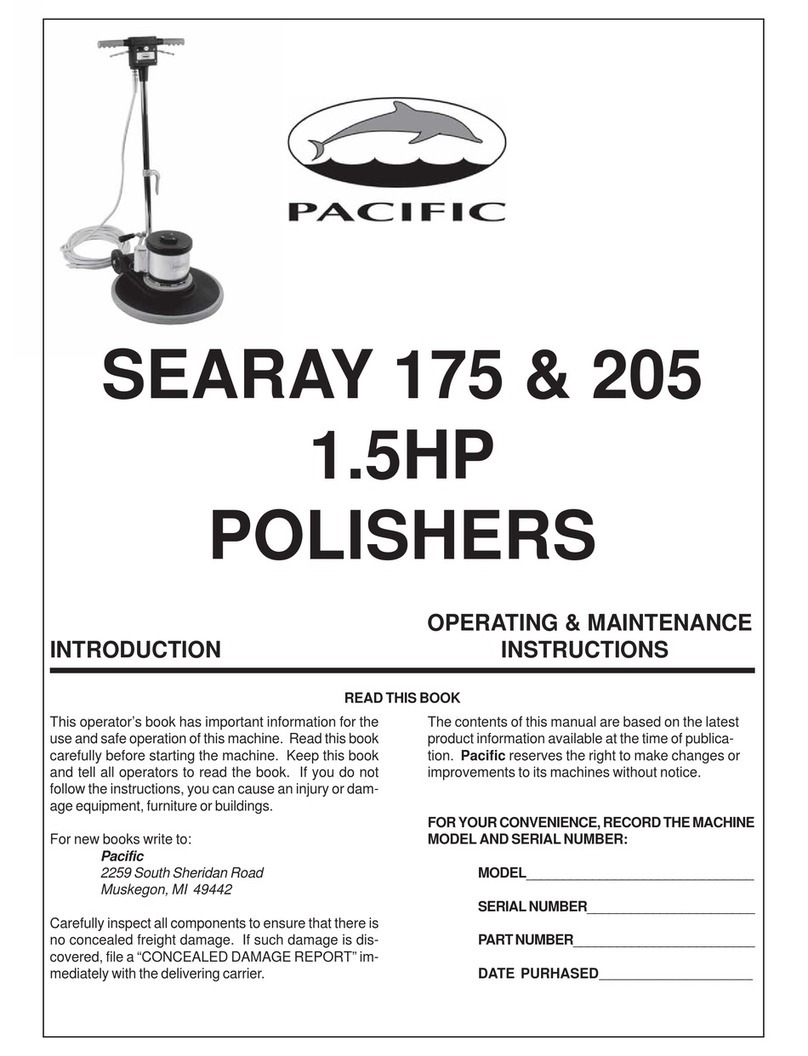
Pacific
Pacific SEARAY 175 Operating & maintenance instructions
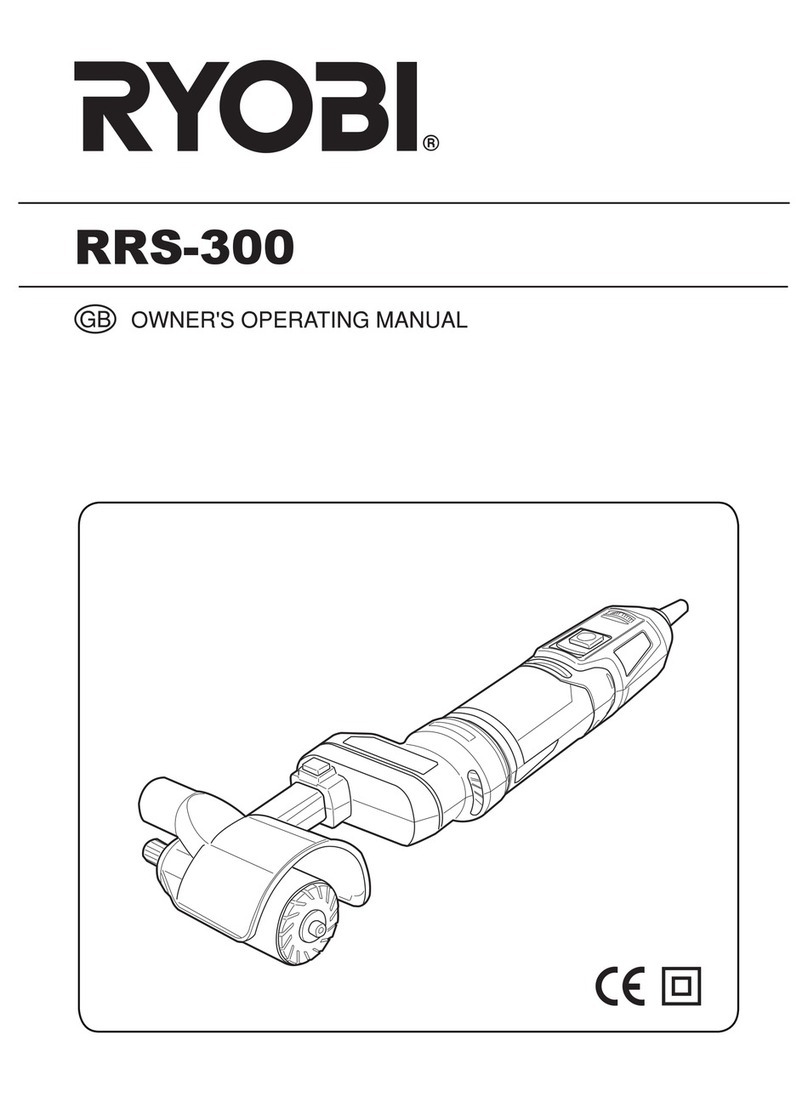
Ryobi
Ryobi RRS-300 Owner's operating manual
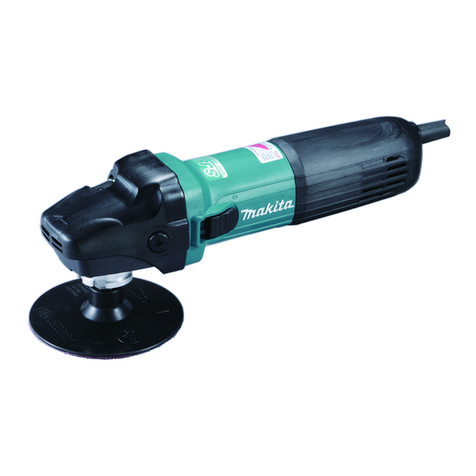
Makita
Makita SA4540C technical information

Meister
Meister MDS280 Translation of the original instructions
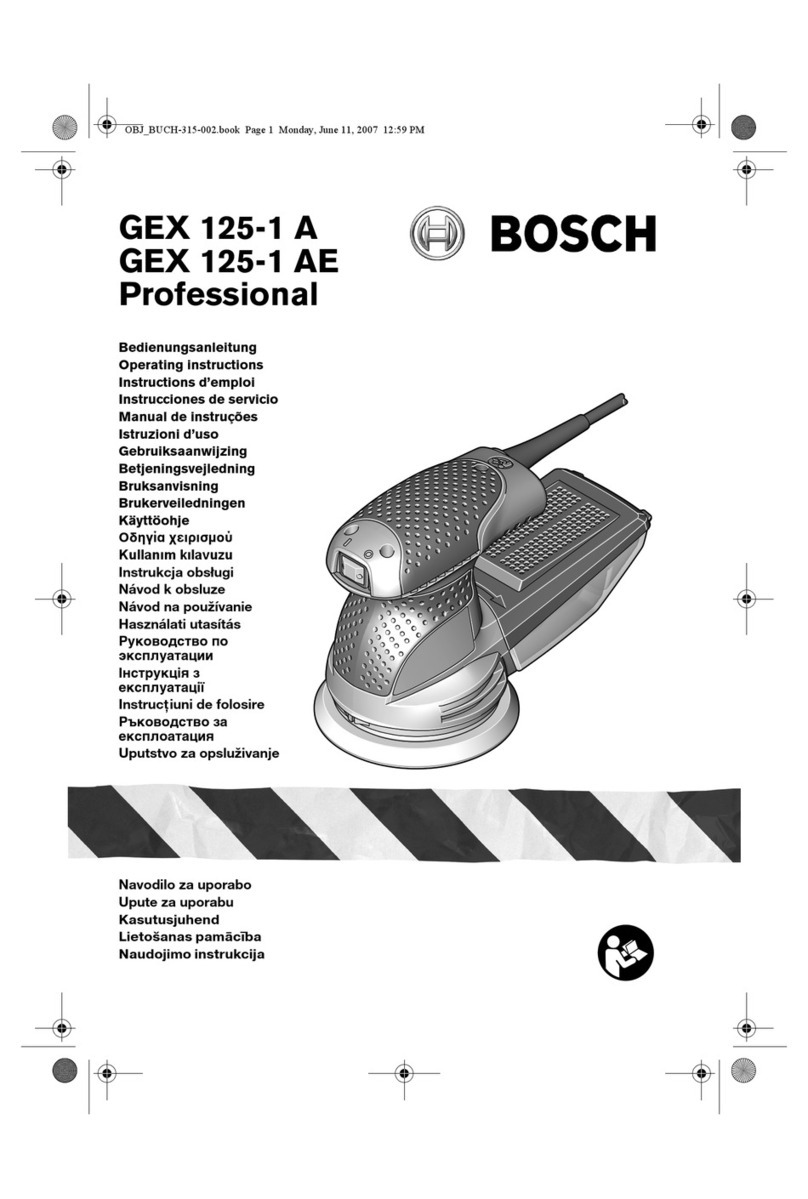
Bosch
Bosch GEX 125-1 A Professional operating instructions

Black & Decker
Black & Decker AST4XC manual

Parkside
Parkside XQ 600 - MANUAL 2 Operating and safety instructions

Meister
Meister MFS320-1 Translation of the original instructions
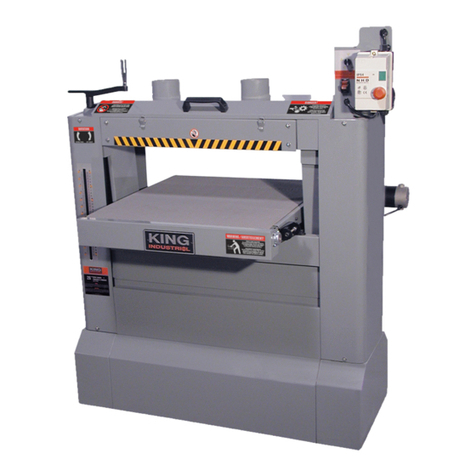
King Industrial
King Industrial KC-26DS instruction manual
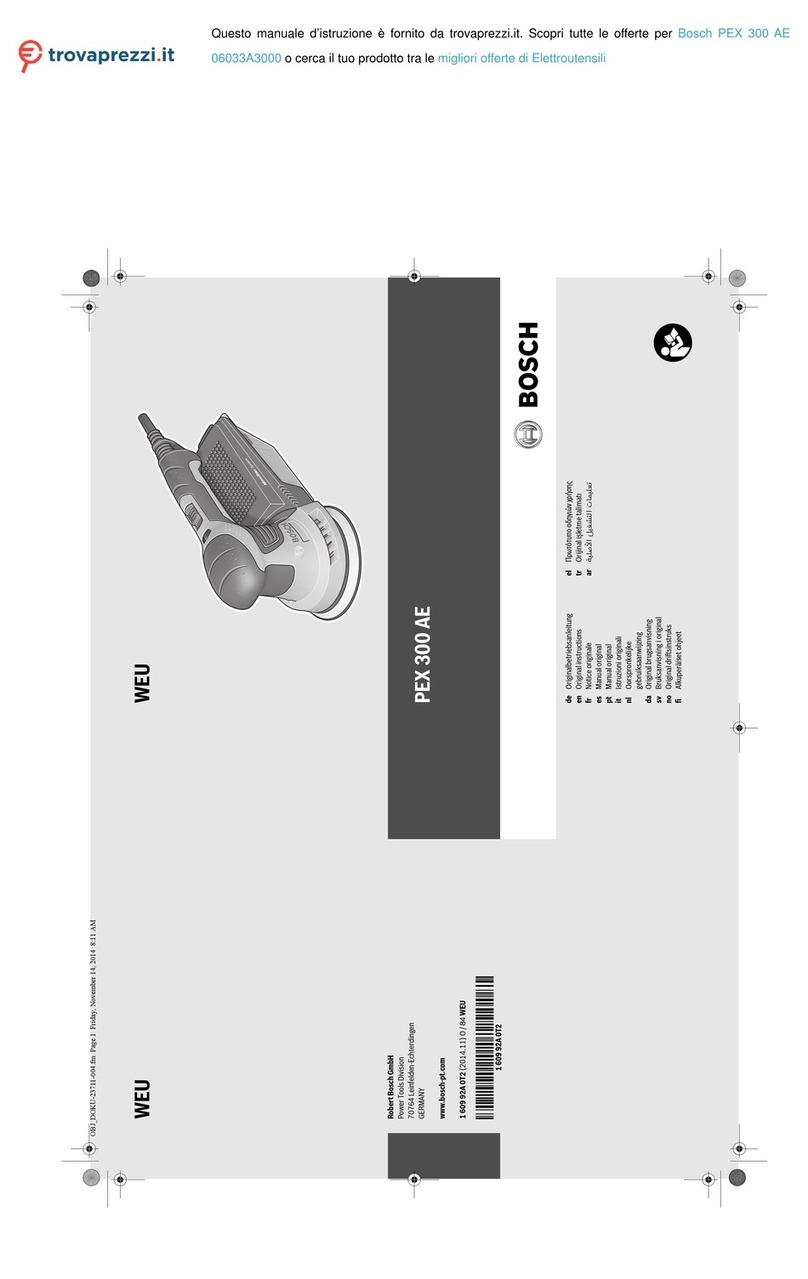
Bosch
Bosch 06033A3000 Original instructions
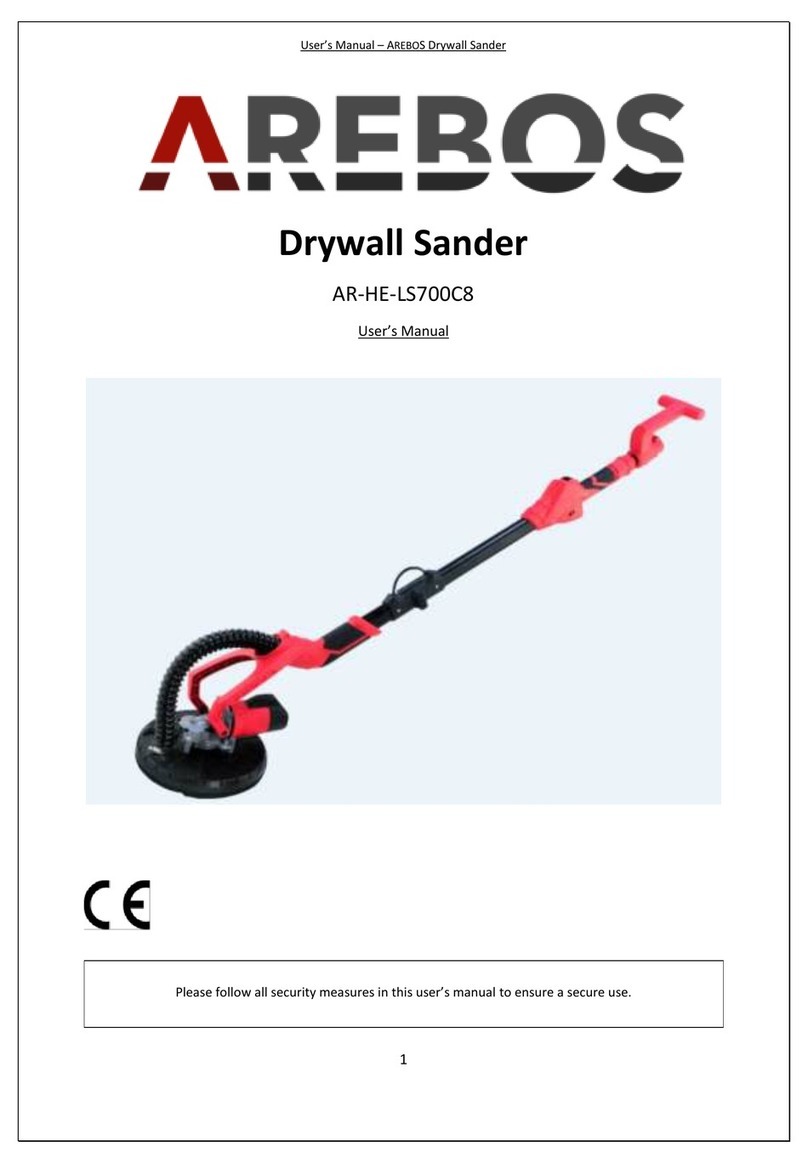
AREBOS
AREBOS AR-HE-LS700C8 user manual
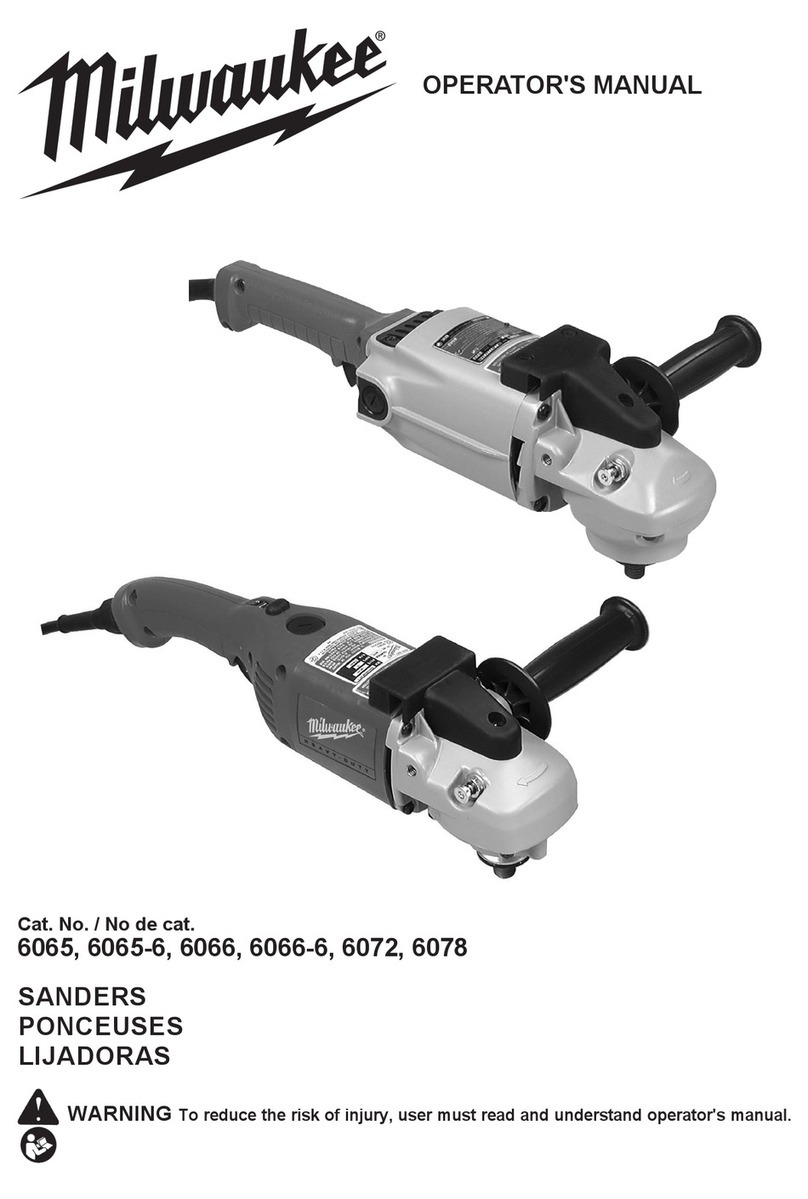
Milwaukee
Milwaukee 6065 Operator's manual
